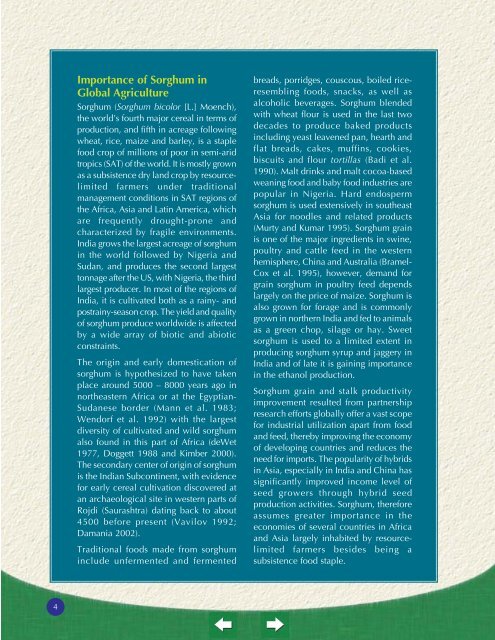Sorghum - icrisat
Sorghum - icrisat
Sorghum - icrisat
Create successful ePaper yourself
Turn your PDF publications into a flip-book with our unique Google optimized e-Paper software.
Importance of <strong>Sorghum</strong> in<br />
Global Agriculture<br />
<strong>Sorghum</strong> (<strong>Sorghum</strong> bicolor [L.] Moench),<br />
the world’s fourth major cereal in terms of<br />
production, and fifth in acreage following<br />
wheat, rice, maize and barley, is a staple<br />
food crop of millions of poor in semi-arid<br />
tropics (SAT) of the world. It is mostly grown<br />
as a subsistence dry land crop by resourcelimited<br />
farmers under traditional<br />
management conditions in SAT regions of<br />
the Africa, Asia and Latin America, which<br />
are frequently drought-prone and<br />
characterized by fragile environments.<br />
India grows the largest acreage of sorghum<br />
in the world followed by Nigeria and<br />
Sudan, and produces the second largest<br />
tonnage after the US, with Nigeria, the third<br />
largest producer. In most of the regions of<br />
India, it is cultivated both as a rainy- and<br />
postrainy-season crop. The yield and quality<br />
of sorghum produce worldwide is affected<br />
by a wide array of biotic and abiotic<br />
constraints.<br />
The origin and early domestication of<br />
sorghum is hypothesized to have taken<br />
place around 5000 – 8000 years ago in<br />
northeastern Africa or at the Egyptian-<br />
Sudanese border (Mann et al. 1983;<br />
Wendorf et al. 1992) with the largest<br />
diversity of cultivated and wild sorghum<br />
also found in this part of Africa (deWet<br />
1977, Doggett 1988 and Kimber 2000).<br />
The secondary center of origin of sorghum<br />
is the Indian Subcontinent, with evidence<br />
for early cereal cultivation discovered at<br />
an archaeological site in western parts of<br />
Rojdi (Saurashtra) dating back to about<br />
4500 before present (Vavilov 1992;<br />
Damania 2002).<br />
Traditional foods made from sorghum<br />
include unfermented and fermented<br />
breads, porridges, couscous, boiled riceresembling<br />
foods, snacks, as well as<br />
alcoholic beverages. <strong>Sorghum</strong> blended<br />
with wheat flour is used in the last two<br />
decades to produce baked products<br />
including yeast leavened pan, hearth and<br />
flat breads, cakes, muffins, cookies,<br />
biscuits and flour tortillas (Badi et al.<br />
1990). Malt drinks and malt cocoa-based<br />
weaning food and baby food industries are<br />
popular in Nigeria. Hard endosperm<br />
sorghum is used extensively in southeast<br />
Asia for noodles and related products<br />
(Murty and Kumar 1995). <strong>Sorghum</strong> grain<br />
is one of the major ingredients in swine,<br />
poultry and cattle feed in the western<br />
hemisphere, China and Australia (Bramel-<br />
Cox et al. 1995), however, demand for<br />
grain sorghum in poultry feed depends<br />
largely on the price of maize. <strong>Sorghum</strong> is<br />
also grown for forage and is commonly<br />
grown in northern India and fed to animals<br />
as a green chop, silage or hay. Sweet<br />
sorghum is used to a limited extent in<br />
producing sorghum syrup and jaggery in<br />
India and of late it is gaining importance<br />
in the ethanol production.<br />
<strong>Sorghum</strong> grain and stalk productivity<br />
improvement resulted from partnership<br />
research efforts globally offer a vast scope<br />
for industrial utilization apart from food<br />
and feed, thereby improving the economy<br />
of developing countries and reduces the<br />
need for imports. The popularity of hybrids<br />
in Asia, especially in India and China has<br />
significantly improved income level of<br />
seed growers through hybrid seed<br />
production activities. <strong>Sorghum</strong>, therefore<br />
assumes greater importance in the<br />
economies of several countries in Africa<br />
and Asia largely inhabited by resourcelimited<br />
farmers besides being a<br />
subsistence food staple.<br />
4
















